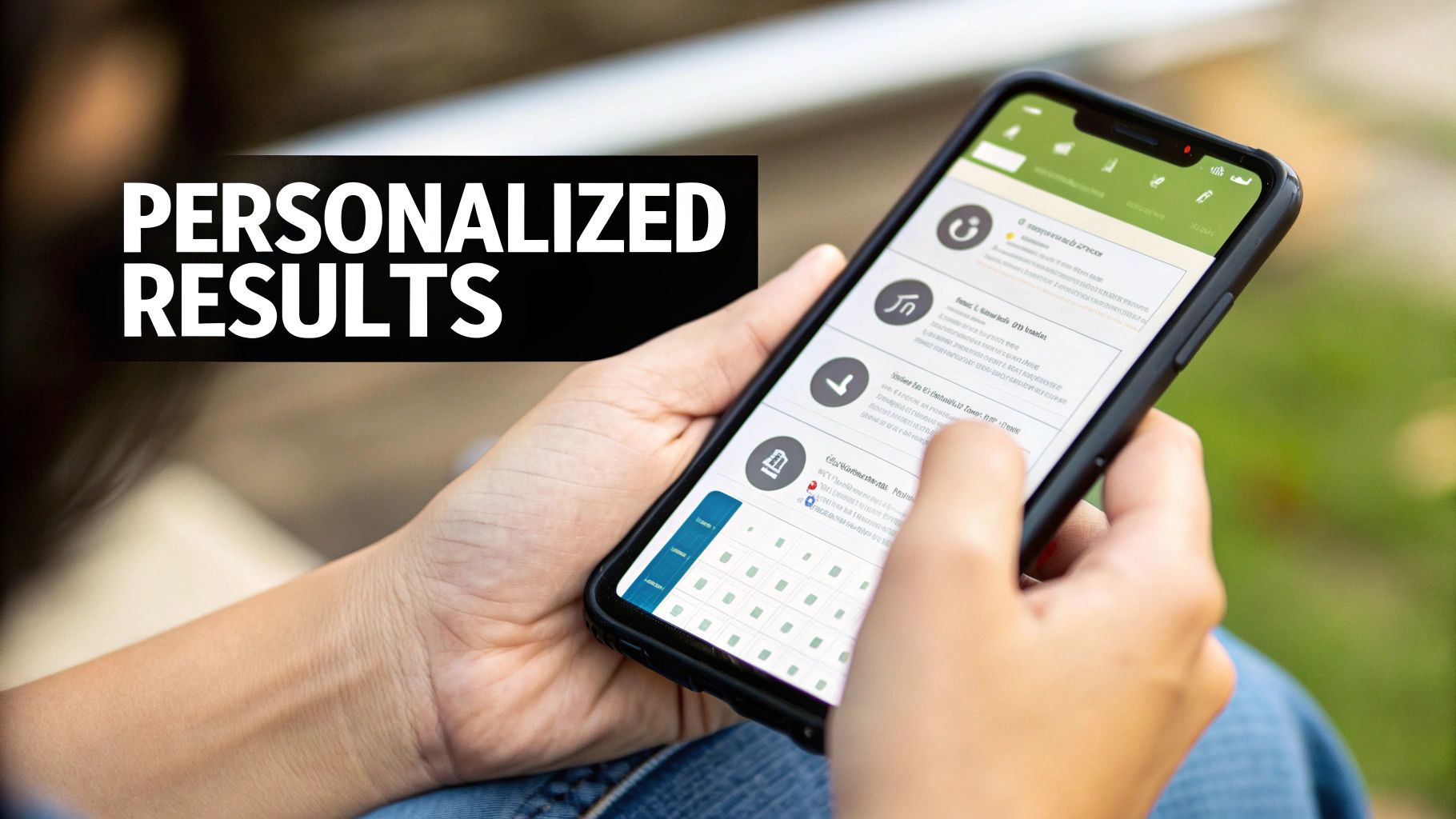
Create Content That Captures Attention
Making an impact online requires more than random posts – it takes thoughtful content that truly connects with your audience. From blog posts to social videos, the bar for quality content keeps rising. What worked five years ago won't achieve the same results today. The real challenge is understanding what content will grab attention, start conversations, and help you hit your goals.
Great content directly addresses what your audience cares about. It teaches them something valuable, entertains them, or helps solve their problems. The key is matching the right format to your message – whether that's an in-depth article, quick social post, or engaging video. Successful creators constantly test new approaches while staying focused on what resonates with their specific followers.
This guide provides 10 proven content ideas to help entrepreneurs, marketers, podcasters, agency owners and solopreneurs grow their online presence. You'll discover practical strategies to engage your target audience and drive real results, no matter your industry or skill level. Let's explore ways to create content that truly connects.
1. Educational How-To Videos
Educational how-to videos let creators share step-by-step instructions in an engaging, visual format. Whether explaining a DIY project or walking through a technical process, these videos help viewers learn new skills by showing and telling at the same time.
YouTube helped make how-to videos mainstream. Educational pioneers like Khan Academy showed how effective these videos could be for teaching complex topics. Tech reviewers like MKBHD and study music channels like ChilledCow further expanded what's possible with the format. Today, how-to videos are a go-to resource for learning new things.
What makes how-to videos work so well? They break down complex ideas with clear visuals, provide actionable step-by-step guidance, and directly address specific problems people search for. Screen recordings work great for software tutorials, while physical demonstrations help with hands-on projects. For example, Tasty's cooking videos use closeup shots to make recipes approachable, and iFixit's repair guides combine detailed visuals with concise instructions.
Pros:
- Strong search intent: People actively look for solutions, making these videos consistently valuable
- Builds expertise: Teaching others positions you as a trusted expert
- Multiple income streams: Earn through ads, sponsors, affiliate links, and related products
- High engagement: Viewers actively follow along and practice what they learn
Cons:
- Time-intensive production: Quality videos require careful planning and editing
- Public speaking skills needed: Must explain concepts clearly and keep viewers engaged
- Equipment costs: May need quality mics, cameras, and lighting
- Regular updates required: Content can become outdated as things change
Tips for creating impactful how-to videos:
- Keep segments short and focused: Break complex topics into digestible chunks
- Add chapter markers: Help viewers find specific sections easily
- Write detailed descriptions: Include keywords and resource links
- Target specific problems: Address common pain points with clear solutions
Educational how-to videos give entrepreneurs, marketers and creators a way to share expertise, grow an audience and generate income. With some planning and practice, this format can help you achieve your content goals.
2. Short-Form Video Content

Short-form videos have become a major part of online content. These quick, engaging clips that run from 15-60 seconds are perfect for platforms like TikTok, Instagram Reels, and YouTube Shorts. What makes this format special is how it combines wide reach and low production costs with the chance to go viral.
People's viewing habits have shifted toward quick, mobile-friendly content. Creators like Charli D'Amelio, Khaby Lame, and Addison Rae showed how simple ideas could gain millions of followers through dance videos, funny skits, and relatable moments.
Key Elements of Great Short Videos:
- Smart Editing: Quick cuts and smooth transitions keep people watching
- Strong Opening: The first few seconds must grab attention immediately
- Popular Music: Using trending songs helps boost views and engagement
- Vertical Format: Perfect for phone viewing and scrolling
Benefits:
- Viral Success: Short videos can spread quickly across social media
- Easy Production: Most can be filmed on phones with basic editing
- Fast Creation: Quick format means more content more often
- Young Audience: Popular with teens and young adults
Challenges:
- Brief Popularity: Trends fade quickly in short-form content
- Crowded Space: Many creators compete for attention
- Limited Detail: Short length restricts complex topics
- Platform Differences: Content may need adjusting for each platform
Real Success Stories:
- Khaby Lame: His simple, wordless reactions to silly life hacks got millions of views
- BuzzFeed Recipes: Quick cooking videos that show useful tips in seconds
- Dance Challenges: Simple moves set to popular songs that everyone can try
Tips for Making Great Short Videos:
- Nail the Opening: Hook viewers in the first 3 seconds
- Watch the Trends: Use popular hashtags and themes
- Pick Good Music: The right song makes videos more engaging
- Keep it Simple: One clear message works best
Short videos offer a unique way to connect with audiences quickly and effectively. By understanding these basic principles and putting them into practice, you can use short-form content to grow your following and achieve your goals online.
3. Long-Form Blog Posts
Quality long-form blog posts are essential for content marketing success. These detailed articles, typically over 2,000 words, provide readers with thoroughly researched information and expert perspectives on specific topics. When done well, they help build authority, attract organic traffic, and achieve business objectives.
Why Long-Form Content Works
Search engines favor content that fully answers user questions, while readers seeking detailed information tend to spend more time with comprehensive articles. Industry experts like Brian Dean, Neil Patel, and Moz have shown how in-depth content builds dedicated audiences and drives traffic. For example, Backlinko's link building guides often reach 5,000+ words and include original research and case studies. Similarly, HubSpot's marketing library features extensive articles covering all aspects of digital marketing.
Key Features of Long-Form Posts:
- Deep research: Includes data, statistics, and expert insights to provide real value
- SEO benefits: More opportunities for relevant keywords and linking
- Clear structure: Well-organized sections with descriptive headings
- Mixed media: Strategic use of images, videos, and graphics
Main Advantages:
- Ranks well for multiple keywords
- Shows your expertise and builds trust
- Provides lasting value and traffic
- Gets shared more on social media
Key Challenges:
- Takes significant time to create
- Requires strong writing ability
- Needs regular fact-checking and updates
- Longer production timeline
Tips for Creating Effective Long-Form Content:
- Research target keywords using tools like Ahrefs
- Include original data and case studies
- Break content into scannable sections
- Add relevant visuals to improve engagement
By focusing on quality, research, and reader value, you can create long-form content that helps achieve your content marketing goals. The key is maintaining high standards while providing genuinely useful information to your audience.
4. Podcast Episodes

Podcasts offer a fantastic way for entrepreneurs, marketers, and freelancers to share their expertise and connect with audiences. Through conversations, interviews, and solo episodes typically running 30-90 minutes, hosts can build genuine relationships with listeners while establishing authority in their field. The format's growing popularity and easy consumption make it an essential content type to consider.
The podcast world has come a long way since its early days. NPR pioneered engaging audio storytelling, while shows like The Joe Rogan Experience proved that long-form conversations could attract millions of listeners. Today, podcasts cover every topic imaginable, making them perfect for niche marketing.
Key podcast features that drive their success:
- Easy listening format: People can tune in while driving, exercising, or doing other tasks
- Flexible style options: Choose between interviews, solo shows, or narrative storytelling
- Series-based content: Builds a loyal following through regular episodes
- Wide distribution: Reaches listeners through Apple Podcasts, Spotify, and other major platforms
Benefits:
- Large listener base: Podcast audiences continue to grow each year
- Strong connections: Regular voice content helps build trust with listeners
- On-demand access: People can listen whenever and wherever they want
- Simple startup costs: Basic equipment needs make entry barriers low
Challenges:
- Sound quality matters: Poor audio can drive listeners away
- Production takes time: Recording and editing require consistent effort
- Growth is gradual: Building an audience usually happens slowly
- Competition is high: Standing out takes work and patience
Success Stories: Shows like Smart Passive Income and Serial showcase different winning approaches – from business advice to true crime storytelling.
Getting Started:
- Buy good gear: Invest in a quality microphone and recording software
- Set a schedule: Release episodes regularly to keep listeners engaged
- Add show notes: Include episode summaries and relevant links
- Plan your content: Map out clear episode structures
Want to learn more? Check out How to Start Podcasting: A Complete Journey From Idea to Launch for detailed guidance on launching your show. Remember – focusing on your specific niche and delivering real value are key to podcast success.
5. Interactive Infographics
When it comes to sharing complex data, interactive infographics pack a powerful punch. Unlike static images, these dynamic visualizations let users explore information at their own pace and dig into the details that interest them most. The result? Information becomes more digestible, memorable, and shareable.
Here's what makes interactive infographics stand out:
- Click and Explore Features: Users can interact through clicks, hovers, animations, quizzes, and polls – turning passive viewing into active discovery
- Clear Data Visualization: Charts, graphs, maps and visual aids break down complex information into understandable chunks
- Smart Screen Adaptation: The content adjusts smoothly across devices, from desktop to mobile
- Easy Social Sharing: Built for sharing on social media and embedding on websites
Key Benefits:
- Higher User Engagement: People spend more time exploring interactive content compared to static images
- Better Understanding: Breaking complex topics into bite-sized, interactive pieces helps users grasp and remember key points
- Lasting Impact: The hands-on experience creates stronger memories
- Wider Reach: The novel format encourages social sharing
Main Challenges:
- Technical Skills Needed: Creation often requires coding knowledge or specialized tools
- Higher Production Costs: More complex than static infographics due to programming needs
- Browser Testing: Must work smoothly across different web browsers
- Mobile Design: Adapting interactive elements for smaller screens takes careful planning
Real-World Examples:
- New York Times Stories: Their interactive features set the standard for data-driven storytelling
- National Geographic: Uses interactivity to explain scientific concepts through stunning visuals
- Bloomberg Graphics: Makes financial data come alive through interactive charts and graphs
Tips for Success:
- Focus on Smooth User Flow: Make navigation intuitive with clear instructions
- Test on Mobile: Ensure everything works well on phones and tablets
- Add Clear Navigation: Help users move easily between different sections
- Check All Platforms: Test thoroughly across browsers and devices
Growing Popularity:
Better web technology and easier-to-use creation tools have helped interactive infographics take off. Leading media outlets like Reuters and Information is Beautiful showcase how powerful this format can be for both storytelling and data presentation.
For marketers, entrepreneurs and content creators, interactive infographics offer an effective way to grab attention and explain complex ideas. They work well across different uses – from marketing campaigns to educational resources to annual reports – making them a smart addition to any content strategy.
6. Email Newsletters
Email newsletters give content creators a direct connection to their audience. By sending curated content directly to subscriber inboxes, newsletters blend original insights with industry updates in a personal way. They help build strong communities and establish the creator as a trusted voice in their field.
Personalization sets newsletters apart from other content channels. Creators can segment their audience and send targeted content that matters most to each group. For example, podcast creators might focus on audio editing tips for some subscribers while sending business growth strategies to others. Regular sending schedules also help maintain steady engagement with subscribers.
The advantages of newsletters are clear. They let creators communicate directly with their audience without social media algorithms getting in the way. Well-crafted newsletters typically see higher engagement than other content types. Over time, delivering consistent value helps build trust and authority. Newsletters also provide strong monetization options through sponsorships, affiliate links, and premium content offerings.
Of course, newsletters come with their own challenges. Creating quality content consistently takes significant work. Technical issues like emails landing in spam folders can limit reach. Many subscribers also feel overwhelmed by crowded inboxes. Smart planning and maintenance helps overcome these hurdles. For more insights, check out Email Marketing Best Practices to Drive Results.
Notable success stories showcase what's possible. Morning Brew turned concise business news with personality into a newsletter reaching millions of subscribers. Platforms like Substack and TheSkimm have made it easier than ever to start and grow a newsletter. These examples prove that well-executed newsletters can build massive, engaged audiences.
For entrepreneurs, marketers, freelancers, podcasters and agency owners, email newsletters are essential tools for growth. You might be interested in: [How to grow your email list]. (This is a placeholder – you should link to a relevant resource if available.)
Key tips for newsletter success:
- Segment your audience: Send targeted content based on subscriber interests
- Write compelling subject lines: Give people a reason to open your emails
- Keep a consistent schedule: Pick sending times and stick to them
- Include clear calls-to-action: Guide readers toward your desired next steps
With focused effort on personalization, valuable content, and reliable delivery, newsletters help creators build stronger connections with their audience and achieve their business goals.
7. Live Streaming Content
Live streaming has become one of the most engaging ways to connect with audiences directly. It allows real-time video broadcasts featuring Q&As, events, behind-the-scenes content, tutorials, and casual conversations. The immediacy creates authentic connections that other content formats simply can't match.
Why Real-Time Interaction Matters:
The magic of live streaming comes from direct engagement. When viewers can chat, comment, and participate in polls, they actively shape the content. This two-way dialogue builds community and deeper audience relationships. For entrepreneurs, marketers and content creators, this level of engagement is invaluable for growing a loyal following.
Growth and Expansion:
What started with Twitch in gaming has grown into a major content format. Popular streamers like Ninja, Pokimane, and Dr Disrespect showed how live streaming could build massive audiences. The format then expanded to Instagram Live, Facebook Live, and YouTube Live, serving everything from expert Q&As to virtual concerts and product launches.
Key Features and Benefits:
- Direct Viewer Interaction: Chat and Q&A create real conversations
- Community Building: Active participation strengthens viewer bonds
- Natural Content: Unscripted format feels more genuine
- Cross-Platform Reach: Connect on multiple streaming platforms
- Quick Feedback: Get instant audience reactions and insights
- Personal Connection: Build trust through direct interaction
- Simple Setup: Basic equipment gets you started
- Urgency: Live nature motivates viewers to tune in
Pros and Cons:
| Pros | Cons |
|---|---|
| Instant viewer feedback | Technical issues risk |
| Real connection with audience | Needs stable internet |
| Basic equipment works | Time zone challenges |
| Creates viewer urgency | Live performance stress |
Tips for Better Live Streams:
- Check Equipment: Test your internet, camera and mic before going live
- Create Structure: Have key topics planned while staying flexible
- Watch Comments: Answer viewer questions to keep engagement high
- Build Buzz: Share your stream schedule on social media beforehand
Real Examples:
- Gaming Streams: Gamers broadcast gameplay while chatting with fans
- Q&A Sessions: Brands and creators answer follower questions live
- Online Events: Virtual conferences and concerts reach global viewers
Why Live Streaming Matters:
Live streaming's ability to create real-time connections makes it essential for audience building. The low entry barrier and multi-platform options make it accessible for entrepreneurs, marketers, podcasters and agency owners. It helps show the human side of your brand while building authority in your field.
8. User-Generated Content Campaigns
A user-generated content (UGC) campaign involves asking your audience to create and share content about your brand. This could include photos, videos, reviews or stories from real customers. The beauty lies in its simplicity – your audience does the creative work while building authentic connections with your brand.
Why UGC Matters For Your Content Strategy:
When real people share their genuine experiences with your brand, it creates trust and credibility that paid advertising simply can't match. UGC campaigns provide fresh content while keeping costs low. Plus, when participants share content with their networks, your brand reaches whole new audiences organically.
Key Benefits:
- Community Building: UGC helps create meaningful connections between your brand and customers
- Expanded Reach: Content spreads naturally through participants' social networks
- Trust Building: Real customer experiences build credibility more effectively than polished brand messages
- Multi-Channel Impact: UGC works across social media, websites, email and more
Advantages:
- Budget-Friendly: Reduces content creation costs compared to professional production
- Higher Engagement: Natural interaction boosts social metrics and community growth
- Authentic Reviews: Real customer stories resonate with potential buyers
- Stronger Loyalty: Active participation strengthens connections to your brand
Challenges:
- Quality Varies: User-submitted content quality can be inconsistent
- Monitoring Required: Need active moderation to maintain appropriate content
- Rights Management: Must have clear terms for content usage and ownership
- Participation Risk: Success depends on audience willingness to contribute
Real-World Success Stories:
Apple's #ShotOniPhone campaign pioneered UGC by showcasing stunning photos taken by iPhone users. GoPro built their brand through customer-submitted action videos. Starbucks turned coffee cup art into viral social content. Adobe engages creators through design challenges that highlight their software's capabilities.
Implementation Tips:
- Set Clear Rules: Create specific guidelines for submissions, themes and formats
- Reward Participation: Offer compelling prizes or recognition to motivate contributors
- Monitor Content: Review submissions to maintain quality standards
- Cross-Promote: Share campaign across multiple channels to boost participation
By thoughtfully planning and managing a UGC campaign, you can harness your audience's creativity while building an engaged community around your brand. Focus on making participation easy and rewarding to inspire quality contributions that benefit both your brand and participants.
9. Case Studies
Case studies are powerful proof points that show what you can actually deliver. They tell the story of real client successes through specific examples and measurable results. A well-crafted case study does more than just describe what you did – it demonstrates the concrete value you provided and helps potential clients envision similar results for themselves.
The classic problem-solution format makes case studies particularly effective. By walking through a client's challenge, your solution approach, and the positive outcomes achieved, you create a narrative that resonates with prospects facing similar issues.
Key Elements of Strong Case Studies:
- Clear results and metrics: Focus on specific, quantifiable outcomes
- Visual data presentation: Use charts and graphics to illustrate key points
- Logical flow: Structure around problem > solution > results
- Client quotes: Include authentic testimonials to build credibility
Benefits:
- Proves expertise: Shows your real-world capabilities through examples
- Demonstrates ROI: Highlights measurable client results
- Supports sales: Provides compelling evidence for your team
- Attracts prospects: Draws in clients seeking similar solutions
Challenges:
- Need client approval: Must get permission to share details
- Resource intensive: Takes time to develop properly
- Regular updates needed: Requires ongoing maintenance
- Hard to scale: Each case study requires custom work
Examples from Leading Companies:
- HubSpot Customer Stories
- Salesforce Success Stories
Tips for Creating Effective Case Studies:
- Focus on numbers: Use specific metrics like "30% revenue increase in 6 months"
- Include key data points: Support claims with actual results
- Craft a narrative: Tell an engaging story about the client's experience
- Add supporting visuals: Use images and charts to highlight key points
History and Growth:
Companies like HubSpot, Salesforce, and Buffer helped establish case studies as essential marketing tools. They showed how real customer stories could effectively demonstrate value and build trust. This approach has since spread across industries.
Target Audiences:
- New business owners: Case studies provide practical examples and inspiration
- Marketing teams: Shows proven strategies and tactics in action
- Agency leaders: Offers content for client pitches and presentations
By following these best practices, you can create compelling case studies that showcase your expertise, build credibility with prospects, and drive real business results.
Content in human-written style:
10. Interactive Quizzes and Assessments

Quizzes and assessments are some of the most effective ways to get your audience actively involved with your content. Rather than just reading or watching, people can participate and discover something about themselves. Look at the success of personality quizzes on BuzzFeed or how Seventeen Magazine built deep connections with readers through their iconic quizzes.
The magic of quizzes lies in their personal touch. People love learning about themselves, testing their knowledge, or just having a few minutes of fun. For content creators, quizzes do double duty – they keep audiences engaged while gathering valuable data about who your readers are and what interests them.
Features and Benefits:
- Interactive Elements: Engaging question formats like multiple choice, sliders, and image picks
- Personal Results: Custom feedback that makes each person feel understood
- Data Collection: Learn about your audience's preferences and interests
- Social Sharing: Make it easy for people to share results with friends
Pros:
- High Engagement: People spend more time with interactive content
- Lead Generation: Collect email addresses by offering personalized results
- Social Sharing: Results that people want to share with friends
- Audience Insights: Learn what your readers care about
Cons:
- Technical Setup: Creating good quizzes needs some technical know-how
- Regular Updates: Quizzes need fresh content to stay relevant
- Platform Limits: Some sites restrict quiz features
- Privacy Balance: Be open about how you'll use people's data
Tips for Great Quizzes:
- Ask What Matters: Focus on topics your audience cares about
- Give Real Value: Provide helpful insights and resources in the results
- Make Sharing Simple: Add clear buttons for social sharing
- Work on All Devices: Test your quiz on phones, tablets and computers
Quizzes deserve their spot on this list because they work – they entertain while delivering real value. Whether you're creating fun personality matches or in-depth knowledge checks, quizzes help you connect with readers in a personal way. Tools like HubSpot make it easier to build and track your quizzes. When done right, quizzes can become a key part of growing your audience and understanding what they want.
Head-to-Head Comparison of 10 Content Creation Ideas
| Method | Difficulty | Time Required | Results | Best For | Key Benefit |
|---|---|---|---|---|---|
| Educational How-To Videos | 🔄 Moderate | ⚡ Longer production | 📊 Evergreen engagement | Skill teaching & authority building | ⭐ Clear step-by-step guidance |
| Short-Form Video Content | 🔄 Low | ⚡ Quick turnaround | 📊 Viral potential | Trend-driven, fast-paced audiences | ⭐ Rapid, broad reach |
| Long-Form Blog Posts | 🔄 High | ⚡ Extensive creation | 📊 Strong SEO & authority | In-depth topic exploration | ⭐ Long-term traffic generation |
| Podcast Episodes | 🔄 Moderate | ⚡ Moderate preparation | 📊 Dedicated listener base | In-depth discussions & interviews | ⭐ Intimate, engaging connection |
| Interactive Infographics | 🔄 High | ⚡ Moderately time-intensive | 📊 Engaging visualization | Data-centric content delivery | ⭐ Simplifies complex data |
| Email Newsletters | 🔄 Low | ⚡ Regular, quick updates | 📊 Direct audience contact | Loyal subscriber communication | ⭐ Personalized delivery |
| Live Streaming Content | 🔄 Moderate | ⚡ Immediate broadcast | 📊 Real-time interaction | Event coverage & live Q&A | ⭐ Authentic, live engagement |
| User-Generated Content Campaigns | 🔄 Low | ⚡ Quick setup, variable | 📊 High engagement/social proof | Community building | ⭐ Cost-effective authenticity |
| Case Studies | 🔄 Moderate | ⚡ Moderate, research-based | 📊 Credibility & lead generation | Sales and marketing enablement | ⭐ Proven, results-driven story |
| Interactive Quizzes & Assessments | 🔄 High | ⚡ Moderate development | 📊 Engagement & data capture | Audience interaction & lead generation | ⭐ Personalized, interactive experience |
Elevate Your Content Strategy: From Ideas to Impact
Creating content that connects with your audience takes many forms – from how-to videos and short clips to blog posts, podcasts, and interactive experiences. The path to success starts with really getting to know who you're trying to reach and what kind of content they respond to best. Each format, whether it's email newsletters, live streams, or content from your community, gives you different ways to educate and inspire. Looking at the data behind your content's performance – engagement rates, reach, and conversions – helps you figure out what's working and how to improve.
To put this into practice effectively, begin by clearly defining who you want to reach and what matters to them. Pick content types that match both your goals and what you can realistically produce. Try different approaches, measure the results, and adjust based on what performs well. Setting and sticking to a regular content schedule helps keep your audience engaged and builds a loyal following over time.
Content creation keeps changing with new developments. Short videos, interactive content, and building strong communities are becoming increasingly important. Keep learning about new platforms and ways to share your message. Be open to testing fresh ideas – finding unique approaches helps you stand out.
Key Takeaways:
- Know your audience deeply: Create content that speaks directly to their interests and needs
- Mix up your content types: Combine videos, written posts, audio, and interactive elements
- Let data guide you: Use performance metrics to improve your strategy
- Be ready to adapt: Keep up with new content formats and platforms
- Stay consistent: Regular content helps build an engaged audience
Want to turn your content ideas into real business success? Jason Yormark shares his experience as an agency owner, author, podcaster, and speaker to help others succeed in modern marketing and podcasting. Learn practical strategies from his journey through his content, weekly podcast, and "Anti Agency" project. Start building your independent path today – visit Jason Yormark to learn more.


Leave a Reply